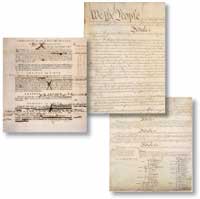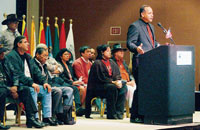国務省出版物
米国の統治の仕組み – 米国の中央政府、州政府、地方政府の概要

首都ワシントンにある国立公文書館のロタンダ(円形大広間)で、1787 年制定の合衆国憲法の原本をながめる来館者。合衆国憲法は、裁判所の解釈に基づき、今も米国の人々の生活を支配している
1776 年、自由と民主主義の試みとして始まった米国の統治制度は、弾力性と適応性が極めて高いことが実証されてきた。
米国は民主主義の国家として分類されることが多いが、より正確に言えば、立憲連邦共和国と定義することができる。これはどのような意味だろうか。「立憲」とは、米国の政府が、国の最高法規である憲法に基づいていることを指す。憲法は、連邦政府と州政府の機構の枠組みを提供するだけでなく、政府の権限に大幅な制限を課している。「連邦」とは、中央の政府と50 州の政府から成ることを意味する。「共和国」は、主権は国民が持つが、選出された代表者がその権力を行使する政体である。
米国を訪れる人の目には、米国の政府は、連邦議会が法律を作り大統領がそれを執行するという、一見分かりやすいものに映るだろう。しかし、もっとつぶさに観察すると、様々な相互作用や影響を伴う、はるかに複雑な制度であることが分かる。
共和国である米国の統治制度における究極の権力は国民に帰属する。この権力は、定期的に実施される選挙によって大統領、連邦議会議員、そして様々な州と地方の公職者を有権者が選出することを通じて行使される。これらの公選職員とそのスタッフは、政策を立案し、法律を作り、政府の日々の運営を指導する。
「国民自身以外に、社会の最高権力の安全な預託先を私は知らない」
トマス・ジェファーソン、1820年
合衆国憲法は、米国の統治制度の青写真である。1788 年に批准されたこの憲法は、3つの独立した政府部門(立法府・行政府・司法府)とその権限、そして各部門の人事の決め方を定めている。

右は、合衆国憲法原本の重なった2ページ分。左は、1789年8月24日、憲法を修正し、17の修正条項から成る権利の章典を追加することを提案した下院合同決議の、注釈付き印刷版。
合衆国憲法を特徴づけているひとつの要素は、3 つの部門に権力を分散させる抑制と均衡の制度である。各部門は、他の部門に対して何らかの形で権限を行使する。例えば、最高裁判所裁判官(司法) は大統領(行政) が指名するが、この指名は上院(立法)の承認を必要とする。同様に、議会で可決され、大統領が署名した法律を、憲法違反であるとして司法が無効にすることができる。こうした抑制と均衡は、いずれかの部門が過度の権限を行使しないように保障している。
政府は憲法で明確に付与された権限しか行使できないため、憲法は国民の権利と権限の重要な保護者である。憲法の修正第1 条から修正第10 条までは、まとめて「権利章典」と呼ばれる。権利章典は、言論・出版・信教の自由、理由のない捜索を免れる権利、陪審による裁判を受ける権利を含む重要な自由をすべての米国民に保障している。
国の最高法規としての憲法は、あらゆるレベルの政府の立法権と行政権を制限している。いかなる法律も、あるいはまた法律の一部も、憲法に抵触すると裁判所がみなした場合には無効となる。こうした問題の最終決定権は、連邦最高裁判所が持っている。
憲法の修正は、上下両院の3分の2の賛成で発議され、4分の3の州議会が批准した場合に採択される。これは困難な手続きであるため、憲法が批准されて以来、現在までに修正は27回しか行われていない。このうち、1800年以降に行われた修正は16回にすぎない。
合衆国憲法は、連邦政府の構成と権限を定めているだけでなく、州政府に関する一般的な規定も含んでいる。各州もまた、それぞれ独自の憲法を持ち、その中に、その州内の地方政府に関する規定が含まれている。地方政府には、市、郡、町、学校区、そして地域の天然資源や交通網などを管理する特別目的区(special-purpose district)などがある。
連邦政府の権限と責任は、合衆国憲法で明確に付与されているものに限定されている。憲法で定められた権限には、州間の通商の規制、国防への支出、貨幣の鋳造、移住や帰化の規制、諸外国との条約締結などが含まれる。
しかし、時の経過とともに、憲法は状況の変化に適応するような解釈や修正が行われ、それに伴い、連邦政府が行使する権限も変わってきた。連邦政府は州政府と協力し、連邦政府が補助金を出して州政府が執行・運営する形の法律や事業を創り出している。教育、社会福祉、住宅・栄養補助、国土保全、運輸、緊急対応は、連邦資金を用い、連邦政府の指針に従って州がサービスを提供する、主要な分野である。
こうした仕組みにより、連邦政府は州に対する影響力を得ている。例えば、連邦政府は1970年代、エネルギー消費を削減するため、幹線道路の制限速度を低くしたいと考えた。そして単に法定制限速度を下げるのではなく、自発的に制限速度を低くしない州に対しては、道路事業の補助金を停止すると圧力をかけた。連邦政府の補助金を受けるには、多くの場合、州も事業資金を一部負担する必要がある。
地方政府は、その州の憲法に基づいて設置される。州政府の制定する政策が連邦法に抵触してはいけないのと同様に、地方政府は、州の憲法や法令が作る法制環境に従属する。
|
インディアン部族の主権 連邦政府の認定を受けたアメリカ・インディアンの部族は、米国内の主権集団と見なされている。主権集団としてのインディアン部族の地位―しばしば「国家の中の国家」と呼ばれる―は、条約や連邦法、裁判所の判決で保護されている。インディアン部族のメンバーは、州や地方の所得税、売上税、不動産税を免除されており、部族の領地では、州は部族の人々を取り締まる権限をほとんど持たない。インディアン部族は、部族の土地をめぐる紛争や部族メンバー間の紛争を解決するため、独自の規則制定機関と司法制度を設けている。インディアン部族の主権は重要ではあるが絶対的なものではない。インディアンは、連邦税を支払い、連邦議会で可決された法律には従わなければならない。 |
 |
Overview of National, State, and Local Governments in the United States
(The following overview is taken from the U.S. Department of State publication, How the United States is Governed.)
The American system of government, begun as an experiment in liberty and democracy in 1776, has proven to be remarkably resilient and adaptable.
While often categorized as a democracy, the United States is more accurately defined as a constitutional federal republic. What does this mean? "Constitutional" refers to the fact that government in the United States is based on a Constitution which is the supreme law of the United States. The Constitution not only provides the framework for how the federal and state governments are structured, but also places significant limits on their powers. "Federal" means that there is both a national government and governments of the 50 states. A "republic" is a form of government in which the people hold power, but elect representatives to exercise that power.
UNDERSTANDING HOW THE AMERICAN SYSTEM OF GOVERNMENT OPERATES
To a visiting observer, the U.S. government may seem straightforward: the Congress makes the laws and the President implements them. A closer inspection reveals a much more complex system of interactions and influences.
As a republic, the ultimate power within the American system rests with the people. This power is exercised through regular, scheduled elections in which voters select the President, members of Congress, and various state and local officials. These officials and their staffs formulate policy, make laws, and direct the day-to-day operations of government.
"I know of no safe depository of the
ultimate powers of the society but the people themselves."
– Thomas Jefferson, 1820
THE ROLE OF THE U.S. CONSTITUTION
The U.S. Constitution is the blueprint for the American system of government. Ratified in 1788, the Constitution defines three separate branches of government (legislative, executive, and judicial), their powers, and how positions in each are to be filled.
One defining characteristic of the Constitution is the system of checks and balances it created to distribute power among the three branches. Each branch exercises some form of power over the others. For example, justices of the Supreme Court (judiciary) are appointed by the President (executive), but subject to the consent of the U.S. Senate (legislative). Likewise, the judiciary can strike down as unconstitutional laws passed by Congress and signed by the President. These and other checks and balances ensure that no single branch of government exercises too much power.
Because the government may exercise only those powers specifically granted to it in the Constitution, the Constitution is an important protection of the rights and powers of the people. The first ten amendments to the Constitution are collectively known as the Bill of Rights. The Bill of Rights guarantees important freedoms to every American, including freedom of speech, press, and religion, and the right to be free from unreasonable searches, and to have a trial by jury.
The Constitution, as the supreme law of the land, limits the legislative and executive powers of all levels of government. Any law or portion of a law that is deemed by the courts to be in conflict with the Constitution is nullified, with the U.S. Supreme Court having the final say in such matters.
Amendments to the Constitution are adopted when proposed by two-thirds of the House and Senate and ratified by three-fourths of the states. This is a difficult process, with only 27 amendments having been made since the Constitution was ratified. Of these, only 16 have been adopted since 1800.
HOW FEDERAL, STATE, AND LOCAL GOVERNMENTS INTERACT
The Constitution not only defines the structure and powers of the federal government, but also contains general provisions regarding state government. Each state, in turn, has its own constitution which contains provisions for local governments within the state. Local governments may include cities, counties, towns, school districts, and special-purpose districts, which govern such matters as local natural resources or transportation networks.
The federal government is limited to the powers and responsibilities specifically granted to it by the U.S. Constitution. Some of the powers listed in the Constitution include regulating commerce between the states, providing for national defense, creating money, regulating immigration and naturalization, and entering into treaties with foreign countries.
Over time, however, the Constitution has been interpreted and amended to adapt to changing circumstances, and the powers exercised by the federal government have changed with it. Working with the states, the federal government creates certain laws and programs that are funded federally, but administered by the states. Education, social welfare, assisted housing and nutrition, homeland security, transportation, and emergency response are key areas where states deliver services using federal funds and subject to federal guidelines.
This gives the federal government the power to influence the states. For example, in the 1970s, the federal government wanted to lower highway speed limits to reduce energy consumption. Rather than simply legislate a lower speed limit, the federal government threatened to withhold money for road projects from states that did not themselves lower the speed limit in their states. In many cases, the states must also partially fund the programs to qualify for federal funds.
A local government is chartered according to its state's constitution. Just as the policies enacted by the state government must not conflict with federal law, a local government is subject to the legal environment created by the state's constitution and statutes.
Acknowledgments
The publisher would like to extend its appreciation to BP America Inc. for its assistance in making this publication possible. The assistance of the following individuals in providing information for this publication is also gratefully acknowledged:
Douglas K. Barry, Ed.D., U.S. Commercial Service, U.S. Department of Commerce
Carol A. Bonosaro, Senior Executives Association
Elizabeth A. Sherman, Ph.D., Presidential Classroom
Donald A. Ritchie, U.S. Senate Historical Office
Paul Rundquist, formerly Congressional Research Service, Library of Congress
Vincent T. Tizzio, American International Group
Dr. Andrew R. Uscher, Senior Executives Association
David K. Voight, U.S. Small Business Administration




